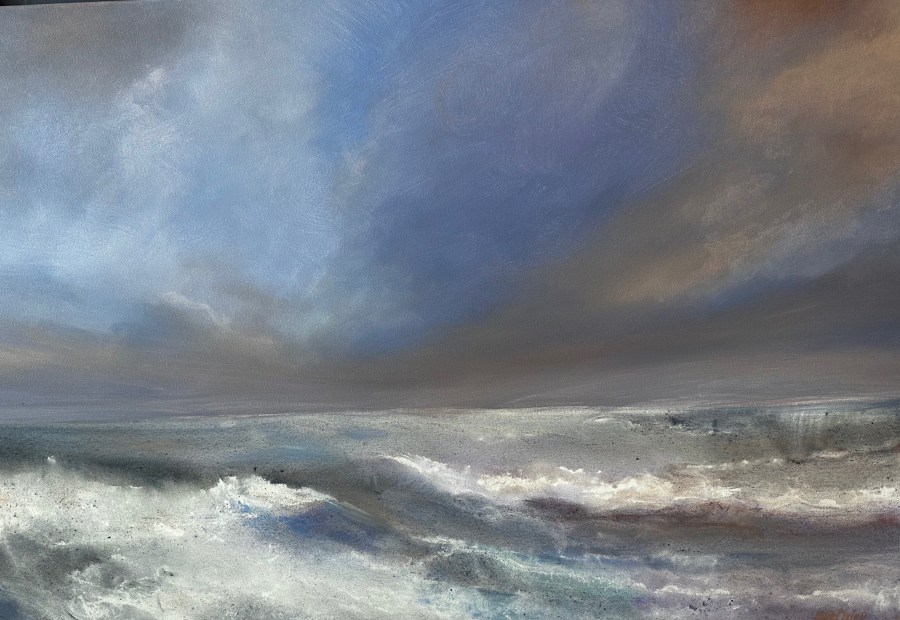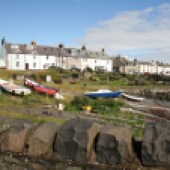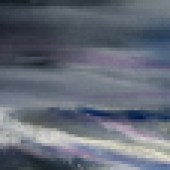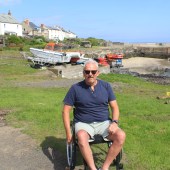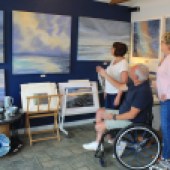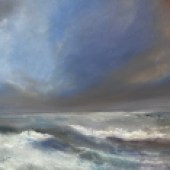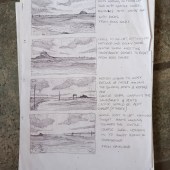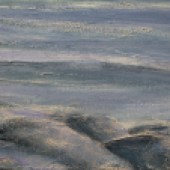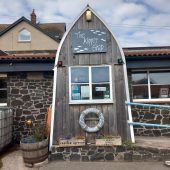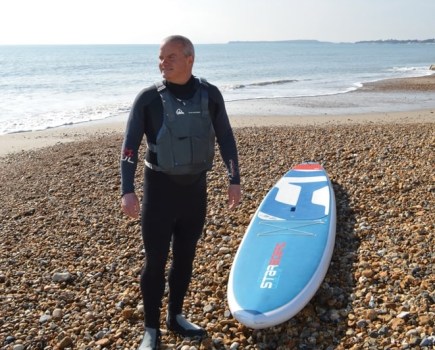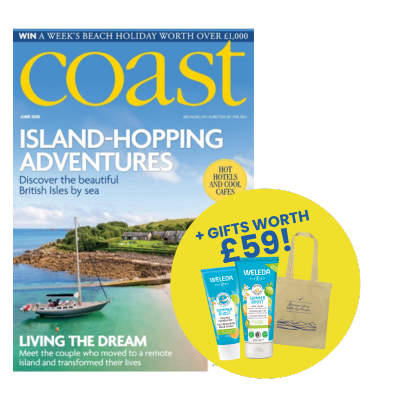The Northumberland coast has always been a major part of Mick Oxley’s life. STEVE NEWMAN explains why today his coastal artwork both in watercolours and acrylic is held in galleries and private collections across the world.
Clinging by its fingernails to the Northumberland coast, the small village of Craster is overshadowed by the romantic walls of Dunstanburgh Castle. Likewise, the walls of its harbour – built to export stone from the nearby quarries – still play host to fishermen unloading their catch. But the glory days of fishing are long gone.
Today the village is more famous for the kippers smoked here but it’s also a magnet for art lovers who visit the gallery of artist Mick Oxley to admire his stunning seascapes created in his own unique style with textured acrylics, portraying the sea in all its moods.
“I had always been captivated by the Northumberland coast,” Mick explains, “spawned by seaside holidays when I was lad at Beadnell where my brother and I would spend all day exploring and playing in the dunes and rockpools.”
Enjoying a career as a P.E. teacher in Bradford, Mick began to suffer from extreme tiredness so much so that he was diagnosed with M.E. (Myalgic Encephalomyelitis, also known as Chronic Fatigue Syndrome) and began suffering exhaustion, especially after exercise.
A native north easterner himself – you can still pick up that Geordie twang when he speaks – he moved with his family to Craster overlooking the sea to rest and recover with his wife and son.
“My condition got worse, and I couldn’t even walk a few steps without feeling exhausted. Gradually I began to realise I would need a wheelchair,” he explains.
The wheelchair, however, gave him a chance to move around and thus expose himself to the sea and the shoreline.
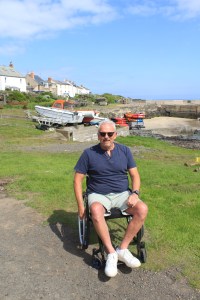
“A wheelchair isn’t a great thing to move over rocks and pebbles but getting outside exposed me to the sea with its taste of salt in the air, waves crashing across the rocks and the sight of a beautiful sunrise reflected on a calm morning,” says Mick.
“I would sit for hours watching the sea and the waves until gradually I began to understand there is so much more to it with the sky and water constantly changing.
“I became so involved with the sea that in my mind I knew I had to do something so I enrolled in an art class in the village. It all started from a hobby but the coast and the sea took over and got into my bloodstream so very quickly.
“The incredible power of art as part of the therapeutic process began to dawn on me and I started to wonder if I could make a career out of painting. Like anyone starting their own business, I was terrified that I would invest so much and it simply wouldn’t work.”
What make his work so different is that you can see and feel the texture of the sea and shore in the canvas. Not many artists would think of using onion bags and other textile materials to achieve this but the results are so effective when you study Mick’s style closely.
Other times acrylic paste mixed with sand and tiny beads are used or, in a nice recycling touch, old bits of rope or netting from the beach.
“After painting a few ‘typical chocolate box views’, I began to paint what was around me. I started with rock pools as I am fascinated by the light and reflections of the receding tide across the shoreline. It’s never the same,” Mick adds.
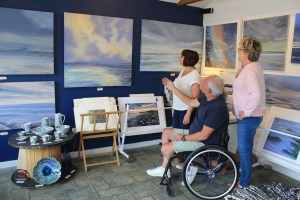
As he worked with a palette knife and brushes I noticed the textiles he was using as I interviewed him. I watched as he applied these to a blank canvas to form the basis of the rocks and clouds then later using only the four colours for that particular painting blending then on the canvas as the picture began to emerge.
“I like to leave a canvas overnight then come back to it and see how I can develop it to what I want to achieve,” he explains.
“From 8am I’m working in the studio, either drawing, texturising or painting. I can be doing this until late morning, often painting to music. I still need time to rest during the day and then I can make sketches from memory for new works or think about new commissions from clients.
“The area around our home is my source of inspiration. To create a piece I absorb everything that I see, smell, feel and hear around me from the gentle lapping of the waves, the roar of angry sea in a storm to the sound of gulls and the wind on my face. Ideas can come just from sitting and staring out to sea, contemplating life and all it throws at you.
“The sea changes so quickly, the clouds, light, the colour of the water and I have to work just as quickly to capture the scene with my sketchbook.”
Getting up every morning to photograph the sunrise as it emerges above the horizon then posting the pictures on social media over the past 12 years, watching and recording the ever changing shoreline, has resulted in his life becoming synchronised with the tide and the sea in all its myriad forms.
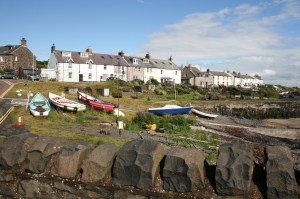
Despite still having the symptoms of ME which at times can be quite debilitating, sometimes having to paint with the wrong hand as his right arm becomes temporarily too weak, his enthusiasm for his art is undiminished. He feels it is important not to neglect his physical health and every morning he travels two or three miles in his wheelchair not only to keep fit but also to seek inspiration.
Today Mick’s enthusiasm for his subject matter, the sea and coast, remains fresh. The quality and volume of his work reflects this, something you cannot fail to notice in his gallery as you walk around.
It is almost as if he has become a part of the Northumberland coast, a form of symbiosis between himself and the sea, sand and wind. That may sound a bit far-fetched but then again, on contemplation, maybe not.
If you want to see how Mick gets his inspiration then you can following his daily photograph taken every morning looking out to sea on Twitter at @SeaSkyCraster. Artwork, both original and limited-edition prints are available to buy from his website: mickoxley.com.
WHEN IN CRASTER…
WHERE TO EAT
The Jolly Fisherman is an award winning Gastro pub with its beer garden overlooking the harbour. It retains the original stone floors and low beam ceilings. thejollyfishermancraster.co.uk/
The ShoreLine Café is situated in the centre of Craster – opposite Mick Oxley’s Gallery. A wide selection of seafood, pasties, sandwiches and ice creams.
There is a seafood shop in Robson’s kipper smokehouse and of course you can buy kippers! Other delights include smoked salmon fishcakes, kipper fishcakes, kipper pate, smoked haddock and cod. kipper.co.uk/
The Piper’s Pitch catering van situated in the courtyard of the Craster Tourist Information Centre. Home of the famous Craster ‘kipper in a bun’ and Auchtermuchty sandwich. Two signature sandwiches inspired by Craster and its beauty. Home bakes, teas and coffees.
WHERE TO VISIT
Craster Tower Stable Yard Nursery has a small farm shop and cafe and is located in the grounds of Craster Tower on the landward side of the stone arch on the approach road to Craster. It has an extensive range of bedding plants, perennials, shrubs and trees.
Dunstanburgh Castle can only be reached on foot. Take the gate to the north of Craster harbour and follow the flat grassy path along the edge of the shore a distance of 1¼ miles. Parking for visitors to the castle is in the main Craster car park next to the Tourist Information Centre. english-heritage.org.uk/visit/places/dunstanburgh-castle/
Howick Hall Gardens and Arboretum offer some of the most spectacular gardens on the Northumberland Coast. Famous as the birthplace of Earl Grey tea it has an excellent visitor centre and soe beautiful woodland walks. howickhallgardens.com/

